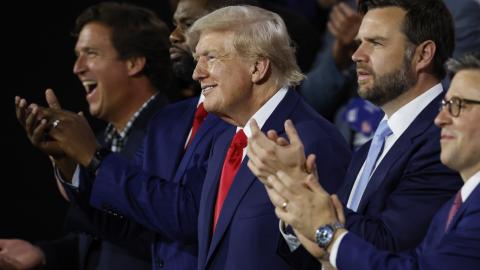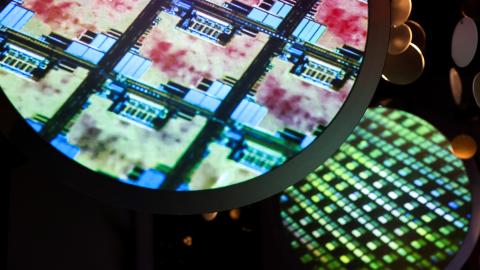If analysts and investors would listen to Federal Reserve Board chairman Alan Greenspan with the same degree of precision equal to that he employs when he speaks, the world of financial markets would be a calmer place. Those who reacted in mild panic to last weeks testimony just werent listening closely to Greenspan.
Suppose, just suppose, that everyone was paying attention when the Fed chairman told congress, Some of the strains that accompanied the difficult business environment of the past several years apparently still linger .Many managers continue to exhibit an unusual reluctance to [add] to their capital stock. Business fixed and inventory investment have risen only moderately .
Greenspan was also less than glowing in his report on the labor market. Cautious behavior has also been evident in the hiring decisions of U.S. firms [They are] restricting their hiring. The average duration of unemployment increased. The increase in real hourly compensation was quite modest between late 2001 and the fourth quarter of 2003.
Most important, Still-significant productivity growth and a sizable margin of underutilized resources, to date, have checked any sustained acceleration of the general price level and should continue to do so for a time. Hardly the words of a central banker with his finger on the panic button. Besides, having admitted that in the past the Fed raised interest rates too rapidly, Greenspan is not likely to throw financial markets into turmoil by repeating that error.
None of this means that the Fed will hold rates at current levels forever. That was never in the cards. But dont pay any attention to pundits who say that Greenspan and his monetary policy committee colleagues will time any change to suit one or another of the presidential candidates. No one would accuse the chairman of being insensitive to the impact of his statements and actions on the ever-nervous politicians in the White House and in congress. But being aware of the political implications of ones policies is not the same thing as tailoring those policies to suit some politician. Remember: Republicans who praised Greenspans wisdom when he supported tax cuts, denounced him as lacking in financial nous when he later expressed unhappiness with large, sustained budget deficits.
So ignore talk that the timing of any change in interest rates will depend on the presidential election cycle. If Greenspan were to raise rates by some tiny amount this summer, the effect on the economy would not be felt until long after voters had made their choice in November. The current President Bush might be slightly unhappy, but remember that Greenspan didnt hesitate to make Bush the elder unhappy with his monetary policy, which some say prolonged the mild recession and cost the presidents father the 1992 election.
What will determine the Feds action is what is going on in the economy. There is no question that commodity prices are rising. The Economists index of those prices is up by almost 60 percent in the past 2-1/2 years, and continued demand from China, a recovering Japan, and a growing U.S. suggest that price pressures will continue. House prices jumped almost 8 percent in 2002 and more than 8 percent in 2003and remain strong. The costs of medical care and education are rising at double-digit rates. Crude oil and gasoline price increases dominate daily discussions on cable channels and in the popular press.
Moreover, Greenspan says he sees a return of pricing power, which should permit firms to pass on some increases, something they have been unable to do in the past. And he sees renewed strength in the economy, which is why he is reminding one and all that some day rates will have to go up.
But not by much and not necessarily very soon. Commodities account for only 20 percent of the costs of American manufacturers, with labor costs making up the bulk of the rest. And, thanks to continued gains in productivity, Greenspan told congress, those costs have yet to post a decisive upturn. Even if they do, the current high level of profit margins suggests that firms may come under competitive pressure to absorb some acceleration in labor costs. Of course, if compensation begins to outstrip productivity gains by a substantial margin, unit labor costs will accelerate, inflation might rise, and the Fed will have to act.
But anyone who has listened carefully to Greenspan would know that the Feds perspective these days is far more global than it has been in the past. In what we might call the olden days, the Fed was alert for signs of emerging pressures on U.S. manufacturing capacity and on the domestic labor supply. Now, Greenspan thinks globally: so long as there is substantial worldwide excess manufacturing capacity, and a pool of low-cost labor eager to find work in the worlds workshops, rising demand need not trigger price rises.
Unless, of course, the new protectionists manage to shield America from access to those overseas resources. The 1974 Trade Act permits America to take unilateral actions against unfair trade practices, and the AFL-CIO contends that poor working conditions in China are just such an unfair practice, one that the unions contend has cost the U.S. 770,000 jobs over the past decade. So the trade unions are asking Bush to impose tariffs of between 12 percent and 77 percent on Chinese goods.
Bush has until the end of this month to decide whether to accept the unions petition, or risk the wrath of many voters by rejecting it. The betting is that Bush will agree to look into the matter, but at a leisurely pace that will allow him to make a decision after the November elections. The wisdom of Ronald ReaganDont just do something, stand thereshould once again enrich policymaking.
This article appeared in Londons Sunday Times on April 24, 2004.



















